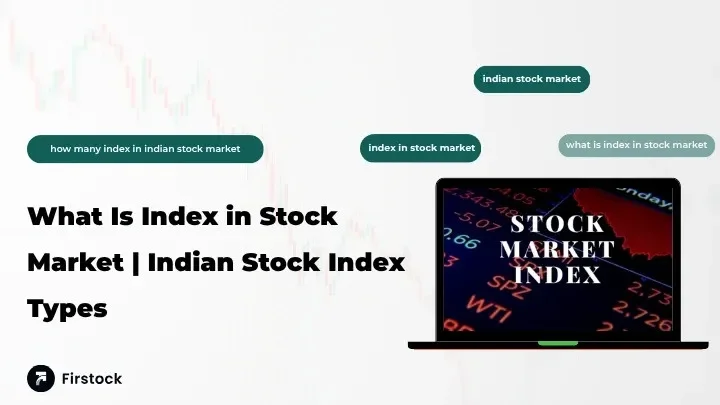What Is Index in Stock Market: A Complete Guide for Beginners
Introduction
Have you ever wondered how experts say “the stock market went up today” even though thousands of stocks are trading at once? That’s where a stock market index comes in. Think of it as the report card of the market — a snapshot showing how a group of stocks is performing.
In this guide, we’ll break down what is index in stock market, explore how many index in Indian stock market, understand popular Indian stock market index types, and even look at how you can track or invest using a trading app in India.
By the end, you’ll understand not just what an index is, but why it’s so important for every investor — from beginners to experts.
Learn what is index in stock market, how many index in Indian stock market, top Indian stock market index, and best trading app in India for investing.
What Is Index in Stock Market?
A stock market index is like a thermometer for the market — it measures the “temperature” or performance of a specific set of stocks.
In simple terms, it’s a collection of selected stocks that represent a particular segment of the market. For example, the Nifty 50 represents the 50 largest companies listed on the National Stock Exchange (NSE), while the Sensex includes 30 top companies from the Bombay Stock Exchange (BSE).
When we say “the market is up,” we usually mean that these indexes have increased in value.
Why Do We Need a Stock Market Index?
Imagine you’re trying to know how India’s economy is doing — you wouldn’t check every single company, right? Instead, you’d look at an index.
A stock market index helps investors and analysts understand:
-
The overall market trend — whether it’s bullish (rising) or bearish (falling).
-
Which sectors (like banking, IT, or energy) are performing well.
-
How to compare one investment with another.
In short, it gives you a big-picture view of the market’s health.
How Does a Stock Market Index Work?
Each index is built using a specific methodology. Companies are chosen based on criteria like:
-
Market capitalization (company size)
-
Liquidity (how easily its shares can be traded)
-
Industry representation
The value of the index changes as the prices of its constituent stocks move up or down.
For example, if Reliance Industries, Infosys, and HDFC Bank rise in price, the Nifty 50 will likely move upward.
How Many Index in Indian Stock Market?
The Indian stock market has over 100 indices across different exchanges and sectors. However, the two main market indices are:
-
Nifty 50 – managed by the National Stock Exchange (NSE)
-
Sensex – managed by the Bombay Stock Exchange (BSE)
In addition, there are sectoral indices, broad market indices, and thematic indices that track specific industries or company types.
Major Indian Stock Market Indexes
Let’s look at some of the most followed Indian stock market index types:
-
Benchmark Indices: Nifty 50, Sensex
-
Broad Market Indices: Nifty 100, Nifty 500, BSE 500
-
Sectoral Indices: Nifty Bank, Nifty IT, BSE Healthcare
-
Thematic Indices: Nifty Next 50, Nifty Dividend Opportunities
Each index gives investors a different perspective on the market’s performance.
Nifty 50: India’s Economic Pulse
The Nifty 50 is one of the most recognized indices in India. Launched in 1996, it represents 50 leading companies across 13 sectors listed on the NSE.
These companies account for a large part of the total market capitalization, making Nifty a reflection of India’s economic strength.
Fun fact: When global investors talk about “the Indian market,” they often mean the Nifty 50.
Sensex: The Oldest and Most Iconic Index
The Sensex, short for “Sensitive Index,” was introduced in 1986 by the BSE. It tracks 30 financially sound and well-established companies from various industries.
Some famous Sensex companies include Reliance Industries, TCS, Infosys, and ICICI Bank.
When the Sensex moves up, it indicates investor confidence and economic growth.
Other Prominent Indian Indices
Beyond Nifty and Sensex, there are several other important indices:
-
Nifty Next 50: The next 50 largest companies after the Nifty 50.
-
BSE 100 & Nifty 100: Represent the top 100 companies.
-
Nifty Midcap 100 and Smallcap 100: Focus on mid-sized and small companies.
These indices allow investors to explore beyond large-cap stocks and diversify their portfolios.
Sectoral Indices in India
Sectoral indices track performance of specific industries. For example:
-
Nifty Bank Index: Measures the performance of major banks like HDFC Bank and SBI.
-
Nifty IT Index: Tracks IT giants such as TCS, Infosys, and Wipro.
-
Nifty FMCG Index: Follows consumer goods companies like Hindustan Unilever.
If you believe a sector (like IT) will grow faster than others, you can invest through index funds tracking that sector.
How Are Indices Calculated?
Most Indian indices use a free-float market capitalization-weighted method.
This means companies are weighted based on their market value and the number of shares available for public trading.
For example, a company with a larger market cap influences the index more than a smaller one.
The index value is adjusted periodically to ensure accuracy and representation.
Market Capitalization and Its Role
Market capitalization (or market cap) is the total value of a company’s outstanding shares.
Formula:
Market Cap = Share Price × Number of Shares
Indexes categorize companies as:
-
Large-cap (big companies like Reliance, HDFC)
-
Mid-cap (medium-sized companies)
-
Small-cap (smaller, fast-growing firms)
Understanding this helps you know what kind of companies an index represents.
How to Invest in Stock Market Index
You can’t buy an index directly — but you can invest in index funds or ETFs (Exchange Traded Funds) that replicate it.
These funds hold the same stocks as the index in the same proportion.
For example:
-
Nifty 50 Index Fund → mirrors Nifty 50
-
Sensex ETF → mirrors Sensex
They’re ideal for beginners since they offer diversification, low cost, and steady long-term returns.
Why Index Investing Is Gaining Popularity
Index investing is becoming the preferred choice for many investors in India. Here’s why:
-
Low fees: No need for fund managers to pick stocks.
-
Diversification: One investment covers many companies.
-
Consistent returns: Tracks market growth over time.
-
Simplicity: Easier to understand and manage.
As Warren Buffett once said, “Most investors are better off with index funds.”
How Trading Apps in India Help You Track Indexes
Thanks to digital innovation, monitoring stock indices is now at your fingertips.
Modern trading apps in India like Zerodha, Groww, Firstock, Upstox, and Angel One let you:
-
Track live index movements (like Nifty 50 or Sensex)
-
Invest in index funds or ETFs directly
-
Analyze sector performance
-
Get educational insights and real-time news
These apps make investing easier, faster, and more transparent — perfect for beginners learning about the Indian stock market index.
Conclusion: Why Indices Matter for Every Investor
In simple words, a stock market index is the heartbeat of the market. It shows how the economy is performing and helps investors make smarter decisions.
From the legendary Sensex to the dynamic Nifty 50, these indices reflect India’s economic journey. Whether you invest directly or through a trading app in India, understanding how indices work will give you a clearer view of where the market is headed.
In the end, it’s like checking the weather before stepping out — indices tell you whether it’s sunny or stormy in the market world!
FAQs
1. What is index in stock market and why is it important?
An index measures the performance of a group of stocks, helping investors track market trends and compare performance easily.
2. How many index in Indian stock market?
India has over 100 indices, but the most popular are Nifty 50 and Sensex.
3. Can I invest directly in an index?
No, but you can invest in index funds or ETFs that mirror the index’s performance.
4. Which trading app in India is best for tracking indexes?
Apps like Firstock, Zerodha, Groww, and Upstox are among the top choices for tracking and investing in indices.
5. What’s the difference between Sensex and Nifty 50?
Sensex tracks 30 top companies listed on BSE, while Nifty 50 tracks 50 top companies listed on NSE. Both represent the overall market movement.







